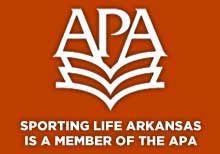LAKE CATHERINE STATE PARK – Researchers from the University of Tulsa and the Arkansas Game and Fish Commission announced today the discovery of a new and unique species of aquatic salamander found at Lake Catherine State Park, near Hot Springs.
A scientific paper describing the two-and-a-half inch long amphibian was recently published in the journal Zootaxa. The Ouachita Streambed Salamander, Eurycea subfluvicola, can be officially added to a growing list of 28 species of salamanders that call Arkansas home. The scientific name “subfluvicola,” which means “dwells below the stream,” refers to this salamander’s habit of moving down into the streambed gravels during the summer months when surface waters dry up.
The discovery was made possible through the collaborative efforts of University of Tulsa Ph.D. student Michael Steffen, his advisor Dr. Ron Bonett, and Arkansas Game and Fish Commission Herpetologist Kelly Irwin. As part of several ongoing research projects in Bonett’s lab, Irwin and Steffen were granted permission to collect salamanders within the state parks system by Arkansas State Parks Director Greg Butts.
 After notifying Lake Catherine State Park Superintendent Richard Boyes, Steffen and Irwin began searching for salamanders along park streams in spring 2011. “We collected the first specimen in late May 2011, but we didn’t know that we had a new species until I sequenced its DNA. That’s because the new species is very similar in appearance to the larvae of the common Many-ribbed Salamander, which live in the same stream,” Steffen said. Hampered by drought conditions, the team spent the next year and a half searching for a second specimen to confirm their initial findings. Their efforts were finally rewarded in February 2013 when additional specimens were collected, and further genetic tests confirmed that they had a distinct new species of salamander.
After notifying Lake Catherine State Park Superintendent Richard Boyes, Steffen and Irwin began searching for salamanders along park streams in spring 2011. “We collected the first specimen in late May 2011, but we didn’t know that we had a new species until I sequenced its DNA. That’s because the new species is very similar in appearance to the larvae of the common Many-ribbed Salamander, which live in the same stream,” Steffen said. Hampered by drought conditions, the team spent the next year and a half searching for a second specimen to confirm their initial findings. Their efforts were finally rewarded in February 2013 when additional specimens were collected, and further genetic tests confirmed that they had a distinct new species of salamander.
Further examination of the new species by Steffen, Bonett and co-author Andrea Blair show that the diminutive, yellowish-brown salamander is not only genetically distinct, but differs from its nearest relative, the Many-ribbed Salamander, in the shape of the head and body, and life history traits. The Ouachita Streambed Salamander is paedomorphic (meaning adults retain larval characteristics throughout life), and this is one of the most distinct new species of paedomorphic salamander discovered within the past 70 years. “Continued support for this type of collaborative research is very important because it helps us to understand the true biodiversity of our wildlife resources. Such information can then be translated into taking appropriate conservation and management actions to insure the continued survival of these species,” Irwin explained.
To date, the Ouachita Streambed Salamander has only be found at two nearby stream sites, one about 150 feet in length, and another approximately 30 feet in length, making this one of the most restricted known ranges for any amphibian species in the U.S. The researchers will continue to search for locations, in areas both inside and outside of the park, in hopes of finding additional populations.
After mapping the locations where they found salamanders, the researchers determined that one site was about to be impacted by sediments washed downstream, which threatened to fill in a pool where the salamanders are most abundant. Thanks to the combined efforts of Steve Filipek and Stephen O’Neal of the Arkansas Game and Fish Commission’s Stream Team Program and Lake Catherine State Park staff, a project was undertaken to remove excess sediment from the streambed and construct a sediment trap to retard movement of additional sediments into the pool.
“I am very pleased to be a part of the discovery and description of yet another species of amphibian that occurs nowhere else in the world but here in Arkansas,” according to Irwin.
Questions about the Ouachita Streambed Salamander can be directed to Kelly Irwin at the Arkansas Game and Fish Commission at 501-539-0431 or kjirwin@agfc.state.ar.us, Ron Bonett at 918-631-3328 or ron-bonett@utulsa.edu, or Mike Steffen at michael-steffen@utulsa.edu at the University of Tulsa.
Courtesy of the Arkansas Game and Fish Commission












